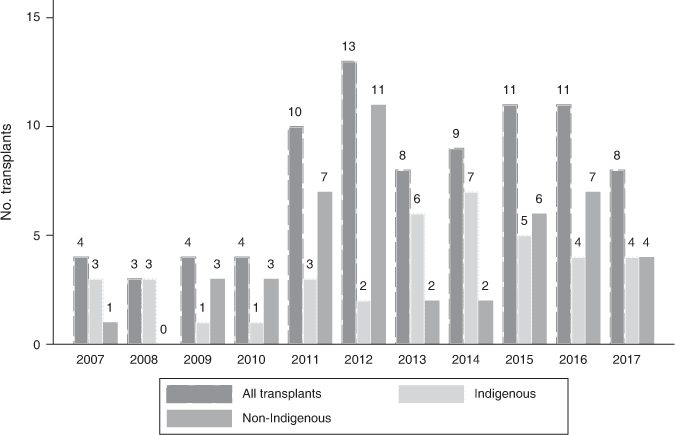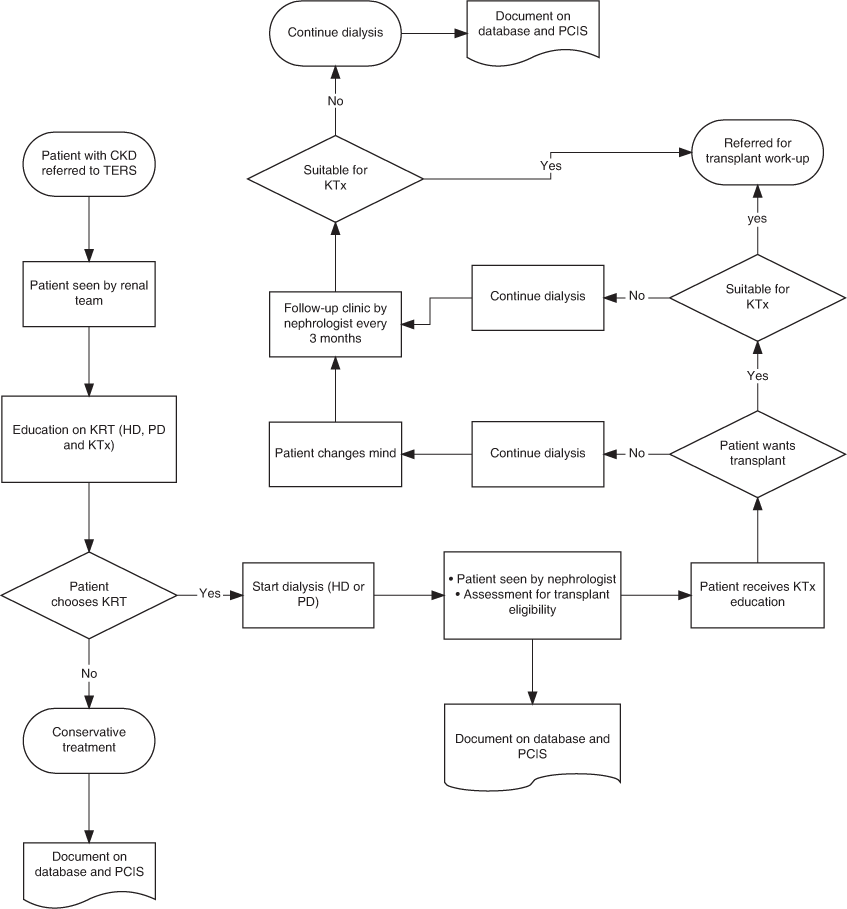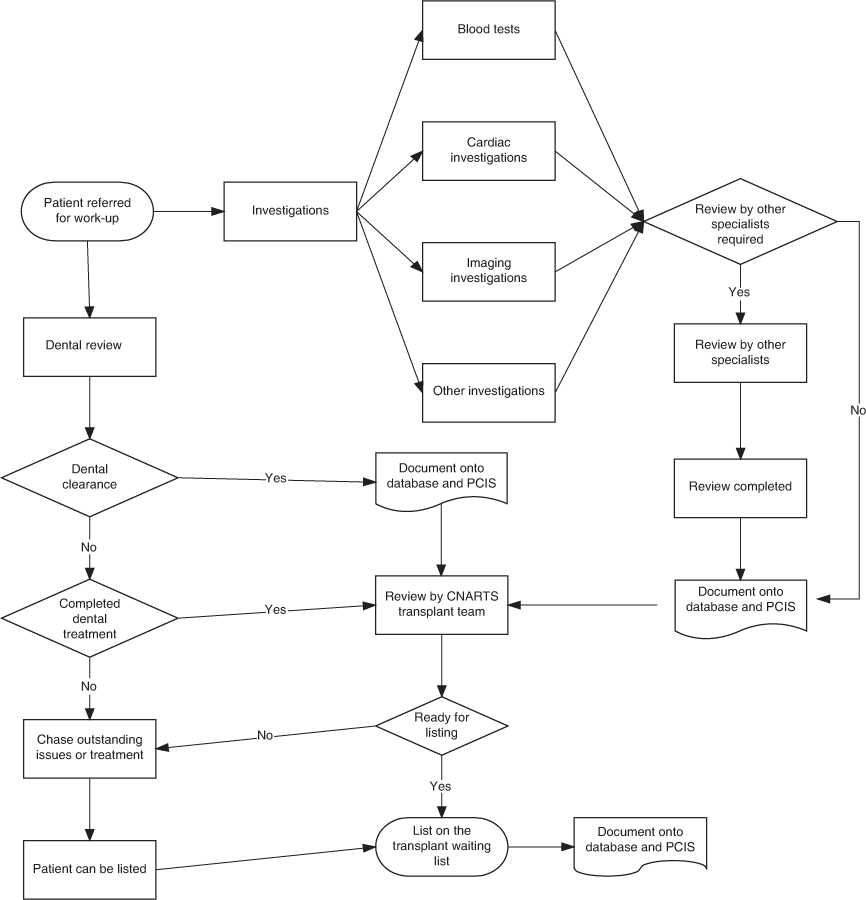Review of current pathways to wait-listing for kidney transplantation for Aboriginal and Torres Strait Islander peoples with end-stage kidney disease in the Top End of Northern Australia
Sandawana W. Majoni A B C E , Kerry Dole A , Jaquelyne T. Hughes A B and Charles Pain D
A B C E , Kerry Dole A , Jaquelyne T. Hughes A B and Charles Pain D
A Department of Nephrology, Division of Medicine, Royal Darwin Hospital, Top End Health Services, PO Box 41326, Casuarina, NT 0811, Australia. Email: kerry.dole@nt.gov.au
B Menzies School of Health Research, Charles Darwin University, PO Box 41096, Casuarina, NT 0811, Australia. Email: jaqui.hughes@menzies.edu.au
C Northern Territory Medical Program, Flinders University, PO Box 41326, Casuarina, NT 0815, Australia.
D Top End Health Services, Executive Suite Royal Darwin Hospital, PO Box 41326, Casuarina, NT 0811, Australia. Email: charles.pain@nt.gov.au
E Corresponding author. Email: william.majoni@nt.gov.au
Australian Health Review 45(2) 185-193 https://doi.org/10.1071/AH20011
Submitted: 19 January 2020 Accepted: 15 June 2020 Published: 8 December 2020
Journal Compilation © AHHA 2021 Open Access CC BY-NC-ND
Abstract
Published evidence confirms poor access to wait-listing for kidney transplantation for Aboriginal and Torres Strait Islander Australians from the Northern Territory. This study aimed to identify the practical causes and recommend improvement. Pathways to wait-listing for a kidney transplant were reviewed to identify potential barriers. Processes were mapped to identify potential problem areas, provide comparison of the actual versus the ideal, identify where data needed collecting and provide clear presentation of the processes. Staff involved in the work-up of patients going for wait-listing were asked to list the barriers. Data were collected for patients from the transplant database between 1 January 2017 to 31 August 2018. Quality improvement statistical processes and charts were used to analyse and present the results. There were 102 patients in the transplant work-up process; 81.4% were Aboriginal and Torres Strait Islander, 71.6% were progressing with the work-up, 28.4% were on-hold. Of the 29 patients on hold, 92.9% were Aboriginal and Torres Strait Islander. Causes of delays to wait-listing included: failure to attend appointments due to competing priorities and communication barriers, access and navigating complex pathways to specialist services, transport, co-morbidities requiring multiple tests and multiple specialty services, and pressures on dialysis and hospital bed capacity. In conclusion, barriers to wait-listing for kidney transplantation for Aboriginal and Torres Strait Islander Australians are complex and can be addressed by redesigning healthcare provision, including increasing the Aboriginal and Torres Strait Islander workforce to provide education and patient navigation of the healthcare system and improve communication, streamlining investigations and coordinating specialist services.
What is known about the topic? Access to wait-listing for kidney transplantation for Aboriginal and Torres Strait Islander Australians from the Northern Territory is poor. Barriers to wait-listing for kidney transplantation can occur anywhere along the pathway of care from a patient’s first contact with the renal service to wait-listing.
What does this paper add? Identified barriers to wait-listing for kidney transplantation include health service workforce and resources shortages, patient and health service barriers such as patients’ competing priorities, poor communication between the health service and patients, transport and accommodation for patients from remote communities, complex comorbidities, and access to specialist services.
What are the implications for practitioners? Recruitment and retention of Aboriginal and Torres Strait Islander mentors, healthcare workers and patient navigators should be prioritised to provide an effective culturally appropriate service. Effective communication strategies with patients and improved access to streamlined appropriate investigations and collaboration among specialist services will invariably improve access to wait-listing for kidney transplantation.
Introduction
Over 70% of patients requiring renal replacement therapy in the Top End of Northern Australia are Aboriginal and Torres Strait Islander peoples. Most must relocate from remote communities to urban areas for dialysis, thus leaving their families, culture and way of life.1 In general, kidney transplantation provides better quality of life and survival, and would be a good option for most of these patients, if suitable, but access to kidney transplantation for this group is very low.2–4 Published literature has demonstrated barriers to wait-listing for kidney transplantation.5–8 Barriers can occur anywhere along the pathway of care from a patient’s first contact with the renal service to wait-listing. This was demonstrated by a recent case of severe dermatophyte infection requiring 394 days to achieve cure, leading to wait-listing 496 days after the patient started dialysis.9 As part of an ongoing quality improvement project, we reviewed the pathways to wait-listing for a kidney transplantation for Aboriginal and Torres Strait Islander Australians.
Objectives
The aims of this study were to: (1) detail the current pathways to wait-listing for kidney transplantation for Aboriginal and Torres Strait Islander patients; (2) identify the practical causes of barriers to wait-listing; (3) recommend and implement improved processes to wait-listing; and (4) recommend and develop ongoing strategies for continuous improvement to improve the care for patients preparing for wait-listing.
Methods
Setting
The Department of Nephrology at a tertiary hospital in the Top End of Northern Australia is the hub of the Top End Renal Service (TERS), providing care, including renal replacement treatments, to people with kidney disease. The transplant service is coordinated by a lead nephrologist, transplant coordinator and up to two other nurses. There are nine nephrologists, most of whom work part-time. All are involved in the preparation and care of patients undergoing kidney transplantation. The Department runs a multidisciplinary service including one psychologist, two renal dieticians, two social workers and four Aboriginal Liaison Officers, all involved in the preparation of patients for kidney transplantation.
Kidney transplantation is performed in South Australia, approximately 3000 km away or 3.5 h travel by air. Patients spend approximately 4 weeks in South Australia after transplantation before being transferred to the tertiary hospital in the Top End.
Pretransplant assessments are performed by the patients’ primary nephrologists and the transplant team, consisting of a surgeon and physician, from South Australia. The team travels to the Top End three to four times yearly, but used to travel according to demand until 2017.
All clinicians proactively discuss transplantation as an option with all new patients referred to the renal service and refer all suitable patients for kidney transplantation.
The project team
The present study was supported and endorsed by members of the multidisciplinary, leadership and management teams within the Department after consultations. The project team consisted of the Executive Director of Medical Services (the lead for Clinical Governance and Quality and Safety for the Top End Health Service), the lead nephrologist for transplantation, the transplant coordinator and one other nephrologist with interest in quality improvement. We used standard methods of performing quality and continuous improvements projects.10
Participants and data collection
Data from medical notes and electronic medical records of patients referred to the renal transplant services were collected over the 20 months from 1 January 2017 to 31 August 2018. Data collected included demographic information, date of referral to the transplant service, when the transplant work-up started and all documented steps through the work-up process. Using Microsoft (Bellevue, WA, USA) Excel spreadsheets, data were entered on every step, including reasons for each decision made during the work-up process to either wait-listing for a transplant, holding off the process or being considered unsuitable for wait-listing.
Emails were sent to all four nursing staff, available nephrologists and other staff involved in the work-up process to list all the reasons identified as potential causes of the barriers to wait-listing.
Key measures of improvement
No guidelines exist on what proportion of patients in a renal program should be wait-listed for kidney transplantation. In order to improve access to the waiting list for patients, TERS aims that at least 20% of all prevalent dialysis patients are on the waiting list. In order to achieve this, the work-up and assessment for wait-listing needs to be completed within 6–12 months for at least 80% of all incident dialysis patients. With over 350 prevalent patients on dialysis and another 40–60 incident patients annually, 70 patients should be on the waiting list and the work-up process should be completed for 32–48 new patients within 12 months of starting dialysis. However, only 15 patients (4%) are currently on the waiting list and 18–24 are undergoing transplantation assessment within 12 months of dialysis initiation.
Summary review of transplant activities from 2010 to 2017
In 2010, a new strategy for offering transplantation for all potential and suitable prevalent patients on maintenance dialysis was instituted to improve access to transplantation. A summary review of the kidney transplantation activities from 2010 to 2017 was performed to obtain an overview of the number of transplants performed during this period. We also included the data from 2007 to 2010 for comparison.
Description of current pathways to wait-listing for kidney transplantation
TERS uses the same transplant work-up and assessment processes regardless of ethnic background. Processes and pathways to wait-listing patients were identified and mapped onto flow charts to: (1) provide a clear visual presentation of the processes; (2) identify potential problem areas; (3) provide an opportunity to compare the actual versus the ideal; and (4) identify where additional data needed to be collected.
Initially, details of all potential causes of barriers were determined to enable: (1) the main causes to be discovered; (2) the problem(s) to be focused on; (3) a snapshot of the collective knowledge to be created for all involved in the project; and (4) analysis and efforts to be focused on the main causes. The main causes were divided into four categories (causes related to staffing; patient-level causes; systems-level causes; and equipment and environmental causes) and plotted onto a cause and effect (Ishikawa/Fishbone) diagram.
Statistical analysis
Descriptive analysis of the pathway to listing from a patient’s first contact with TERS was performed. Based on the Pareto principle, which states that 20% of the sources cause 80% of any problem,10 Pareto charts were constructed to: (1) identify the real main causes and develop a clear recommendation for strategies to overcome these problems; (2) focus efforts on the problems that would offer the greatest potential for improvement by showing their relative frequency or size in a descending bar graph; and (3) help prevent ‘shifting the problem’, whereby the ‘solution’ removes some causes but worsens others.
Data are presented as the mean ± s.d. for normally distributed continuous data and as the median with interquartile range (IQR) for data with a skewed distribution. Frequencies are expressed as percentages. Student t-test or Mann–Whitney U-tests were used for comparisons as appropriate. Details of reasons for delays as provided by staff were tabulated. All analyses were performed using Stata version 15.1 (StataCorp, College Station, TX, USA) and Microsoft Excel.
Ethics approval
This project was approved by the Human Research Ethics Committee (HREC) of the Northern Territory Department of Health and Menzies School of Health Research (HREC: 2019-3285).
Results
Transplant activities from 2010 to 2018
The effects of changes introduced in 2010 started to be evident from 2013, with a small increase in the number of transplants among Aboriginal and Torres Strait Islander patients from 2013 to 2017 (Fig. 1). The number of transplants per year increased significantly from a median of 2.5 (IQR 1.3–3) in 2013 to 5 (IQR 4–6) in 2017 (P < 0.001). Overall, there was no significant difference in the median number of transplants per year between Aboriginal and Torres Strait Islanders (3.5; 95% confidence interval (CI) 2.3–4.8) and non-Indigenous Australians (4.2; 95% CI 2.0–6.4; P = 0.5821).
Fig. 2 shows the potential causes of barriers mapped on a Fishbone/Ishikawa diagram, Fig. 3 details the current pathway from contact with the renal services to starting the work-up and Fig. 4 shows the current processes from starting work-up to wait-listing.
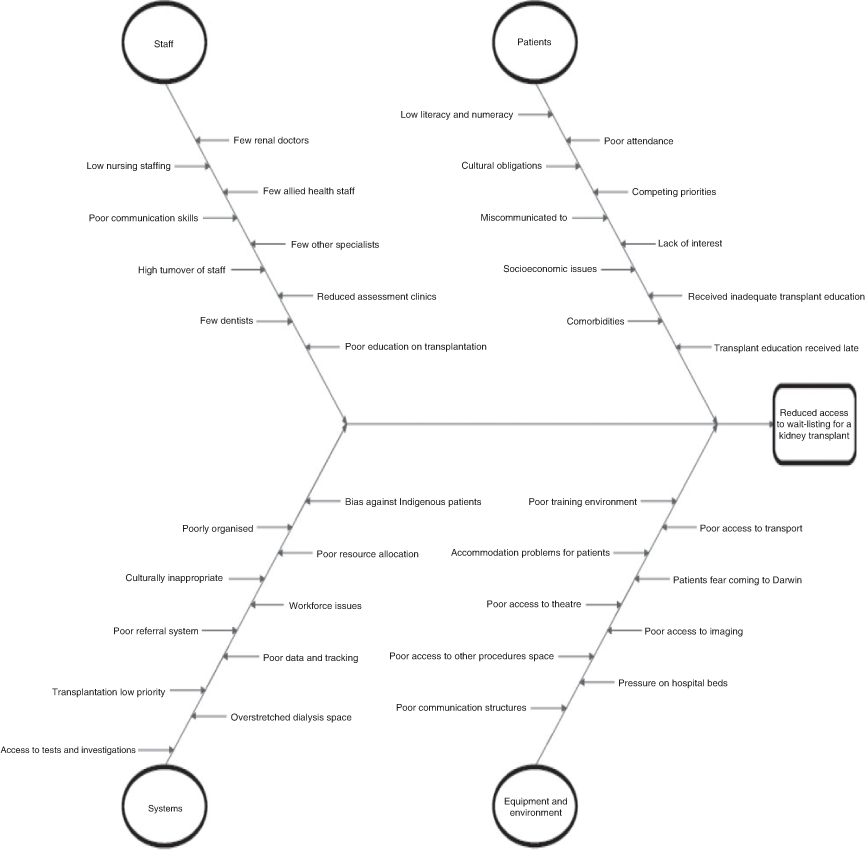
|
Of 102 patients who commenced the transplant work-up process, 83 (81.4%) were Aboriginal and Torres Strait Islanders. The mean age was 50.1 ± 8.1 years, work-up was progressing in 73 (71.6%) but was on hold in 29 (28.4%). Of the 29 patients on hold, 27 (92.9%) were Aboriginal and Torres Strait Islanders.
Identified barriers to listing for kidney transplantation
Health service workforce and staff
One major barrier to listing for kidney transplantation was health service workforce resourcing for the transplant program, with only one full-time nurse position and one other position shared by three nurses rotating from the dialysis unit. With no dedicated administration support, the nurses’ workload included following-up the results of investigations, reminding patients to attend appointments, arranging clinics and post-transplantation patient care and caring for non-transplant renal patients on immunosuppression.
Patient and health service barriers
The Pareto chart in Fig. 5 shows the actual causes of barriers among the 102 patients. Patients not attending or missing dental investigations and other specialist appointments was common. The reasons for attending or missing dental investigations were multifactorial and included competing priorities (e.g. other important engagements such as funerals, important festivals and community commitments), problems with patient transport to appointments, poor communication between health services and patients about their appointments, a lack of patient accommodation, patients being uncontactable and patients losing interest in the whole process.
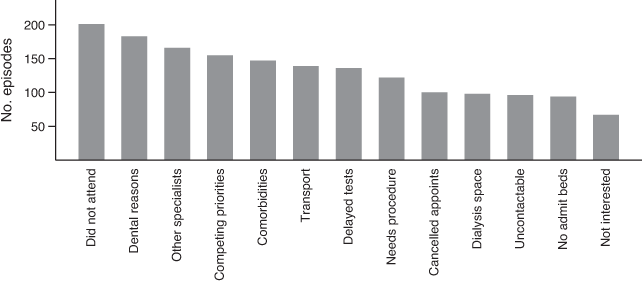
|
Significant comorbidities, such as cardiac disease, diabetes and its complications, skin,9 respiratory and urinary tract infections, poor oral health (a reflection of poor socioeconomic status) and overweight and obesity were also common. All these required more investigations and multispeciality involvement.
Other health service-level factors included a lack of or delayed appointments, long waiting lists for dental and other specialist services (e.g. surgery, urology, ear nose and throat, psychology), cancellation of appointments, a shortage of dialysis space for patients travelling from remote communities for specialised investigations, a requirement for complex medical or surgical procedures and a shortage of hospital admission beds,
Causes identified by staff as barriers were similar (Table 1).
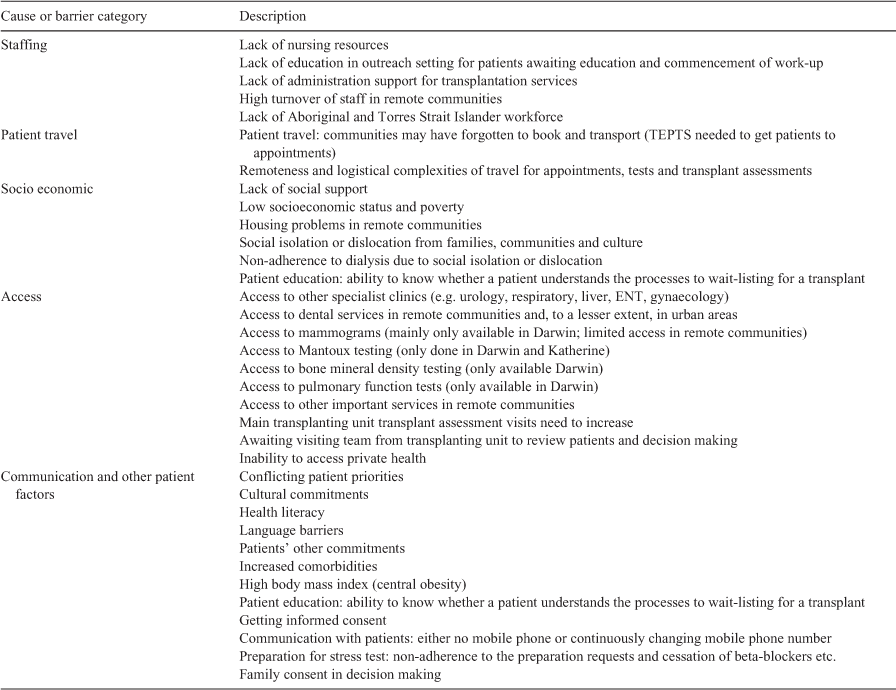
|
Discussion
It took 3 years for transplant numbers to increase after implementation of changes in 2010, reflecting the time taken to wait-list patients due to the barriers described above. All Aboriginal and Torres Strait Islander patients received deceased donor transplants. The shortage of donors may affect the rates of transplantation. However, even with the current donor rates, the number of Aboriginal and Torres Strait Islander patients on the waiting list is still unacceptably low.
The absence of an overall difference in the transplant numbers between Aboriginal and Torres Strait Islander and non-Indigenous patients suggests that the numbers of deceased donor transplants was higher for the former, because most non-Indigenous patients received transplants from living donors. However, the rates of transplantation for Aboriginal and Torres Strait Islander patients are too low because these patients account for over 70% of the dialysis cohort.
Changes implemented include improved data capture and recording, improved patient-level communication, strategies for using effective and culturally appropriate communication methods, such as Yarning Circles,1,11 timely access to specialists and working with patient navigators to assist patients through the work-up process. Other culturally appropriate communication and transplant educational tools to improve engagement are being developed.
Cardiac services now prioritise transplant work-up patients. This change is being broadened to other specialist areas. An agreement has been reached with dental services to prioritise transplant work-up patients.
The results from this project contributed to the national performance report on improving access to transplantation for Aboriginal and Torres Islander patients across Australia submitted to the Commonwealth Department of Health.12
Proactive patient and community engagement and increased collaboration with primary health care to improve general health for patients before they start dialysis will eliminate delays. A patient reference group for TERS has been set up.13
Performing investigations closer to patients’ communities and increasing the use of telehealth will improve access to specialists. The recent appointment of a psychologist within the renal services has closed a significant gap in the service.
Several key recommendations are summarised in Box 1.
| Box 1. Summary of recommendations |
|
Conclusions
Barriers to wait-listing for kidney transplantation for Aboriginal and Torres Strait Islander Australians are complex and can be addressed by innovative improvements in the provision of health care. This includes increasing the Aboriginal and Torres Strait Islander workforce to provide culturally appropriate patient navigation of the healthcare system and improving communication processes between health services and patients. There is a need for streamlined investigations and coordinated specialist services.
Competing interests
The authors declare no competing interests.
Acknowledgements
The authors acknowledge all their colleagues from the Northern Territory Renal Services and the Top End Renal Services for the work they do to improve outcomes for their patients. The authors also acknowledge all their patients, who are partners in their care. This research did not receive any specific funding.
References
[1] Hughes JT, Dembski L, Kerrigan V, Majoni SW, Lawton PD, Cass A. Gathering perspectives – finding solutions for chronic and end stage kidney disease. Nephrology (Carlton) 2018; 23 5–13.| Gathering perspectives – finding solutions for chronic and end stage kidney disease.Crossref | GoogleScholarGoogle Scholar |
[2] Majoni SW, Abeyaratne A. Renal transplantation in Indigenous Australians of the Northern Territory: closing the gap. Intern Med J 2013; 43 1059–66.
| Renal transplantation in Indigenous Australians of the Northern Territory: closing the gap.Crossref | GoogleScholarGoogle Scholar | 23952967PubMed |
[3] Khanal N, Lawton PD, Cass A, McDonald SP. Disparity of access to kidney transplantation by Indigenous and non-Indigenous Australians. Med J Aust 2018; 209 261–6.
| Disparity of access to kidney transplantation by Indigenous and non-Indigenous Australians.Crossref | GoogleScholarGoogle Scholar | 30208818PubMed |
[4] Lawton PD, Cunningham J, Zhao Y, Gray NA, Chatfield MD, Baade PD, Murali K, Jose MD. Survival of Indigenous Australians receiving renal replacement therapy: closing the gap? Med J Aust 2015; 202 297
| Survival of Indigenous Australians receiving renal replacement therapy: closing the gap?Crossref | GoogleScholarGoogle Scholar | 25832149PubMed |
[5] Devitt J, Anderson K, Cunningham J, Preece C, Snelling P, Cass A. Difficult conversations: Australian Indigenous patients’ views on kidney transplantation. BMC Nephrol 2017; 18 310
| Difficult conversations: Australian Indigenous patients’ views on kidney transplantation.Crossref | GoogleScholarGoogle Scholar | 29020932PubMed |
[6] Devitt J, Cass A, Cunningham J, Preece C, Anderson K, Snelling P. Study protocol – improving access to kidney transplants (IMPAKT): a detailed account of a qualitative study investigating barriers to transplant for Australian Indigenous people with end-stage kidney disease. BMC Health Serv Res 2008; 8 31
| Study protocol – improving access to kidney transplants (IMPAKT): a detailed account of a qualitative study investigating barriers to transplant for Australian Indigenous people with end-stage kidney disease.Crossref | GoogleScholarGoogle Scholar | 18248667PubMed |
[7] Anderson K, Devitt J, Cunningham J, Preece C, Cass A. ‘All they said was my kidneys were dead’: Indigenous Australian patients’ understanding of their chronic kidney disease. Med J Aust 2008; 189 499–503.
| ‘All they said was my kidneys were dead’: Indigenous Australian patients’ understanding of their chronic kidney disease.Crossref | GoogleScholarGoogle Scholar | 18976191PubMed |
[8] Cass A, Devitt J, Preece C, Cunningham J, Anderson K, Snelling P, Eris J, Ayanian J. Barriers to access by Indigenous Australians to kidney transplantation: the IMPAKT study. Nephrology (Carlton) 2004; 9 S144–6.
| Barriers to access by Indigenous Australians to kidney transplantation: the IMPAKT study.Crossref | GoogleScholarGoogle Scholar | 15601407PubMed |
[9] Hughes JT, Kirkham R, Aye Min O, Hall H, Currie BJ, Majoni SW. Patient-identified health service transformation: an Aboriginal patient’s experience with extensive chronic tinea corporis and delayed kidney transplantation wait-listing. Renal Soc Australas J 2019; 15 92–6.
| Patient-identified health service transformation: an Aboriginal patient’s experience with extensive chronic tinea corporis and delayed kidney transplantation wait-listing.Crossref | GoogleScholarGoogle Scholar |
[10] Brassard M, Ritter D. The memory jogger II: a pocket guide of tools for continuous improvement and effective planning. Salem: GOAL/QPC; 1994.
[11] Walker M, Fredericks B, Mills K, Anderson D. ‘Yarning’ as a method for community-based health research with Indigenous women: the Indigenous women’s wellness research program. Health Care Women Int 2014; 35 1216–26.
| ‘Yarning’ as a method for community-based health research with Indigenous women: the Indigenous women’s wellness research program.Crossref | GoogleScholarGoogle Scholar | 23980668PubMed |
[12] Transplantation Society of Australia and New Zealand. Improving access to and outcomes of kidney transplantation for Aboriginal and Torres Strait Islander people in Australia. 2019. Available at: https://www.anzdata.org.au/wp-content/uploads/2019/07/TSANZ-Performance-Report-Improving-Indigenous-Transplant-Outcomes-Final-edited-1.pdf [verified 13 May 2019].
[13] Hughes JT, Freeman N, Beaton B, Puruntatemeri AM, Hausin M, Tipiloura G, Wood P, Signal S, Majoni SW, Cass A, Maple-Brown LJ, Kirkham R. My experiences with kidney care: a qualitative study of adults in the Northern Territory of Australia living with chronic kidney disease, dialysis and transplantation. PLoS One 2019; 14 e0225722
| My experiences with kidney care: a qualitative study of adults in the Northern Territory of Australia living with chronic kidney disease, dialysis and transplantation.Crossref | GoogleScholarGoogle Scholar | 31856215PubMed |


